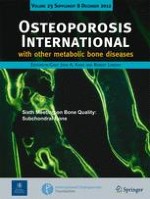Erschienen in:

01.12.2012 | Bone Quality Seminars: Subchondral Bone
CT imaging for the investigation of subchondral bone in knee osteoarthritis
verfasst von:
V. Bousson, T. Lowitz, L. Laouisset, K. Engelke, J.-D. Laredo
Erschienen in:
Osteoporosis International
|
Sonderheft 8/2012
Einloggen, um Zugang zu erhalten
Abstract
In osteoarthritis, magnetic resonance imaging is the method of choice to image articular cartilage and “bone marrow lesions.” However, the calcified cartilage, the subchondral bone plate, and trabecular subchondral bone that are mineralized tissues strongly attenuate X-rays and are therefore potentially accessible for analyses using computed tomography (CT). CT images nicely show osseous cardinal signs of advanced osteoarthritis such as osteophytes, subchondral cysts, and subchondral bone sclerosis. But more importantly, CT can help us to better understand the pathophysiology of knee osteoarthritis from the measurement of the density and structure of subchondral mineralized tissues in vivo. For that purpose, we recently developed dedicated image analysis software called Medical Image Analysis Framework (MIAF)-Knee. In this manuscript, our aims are to present current knowledge on CT imaging of the subchondral bone in knee osteoarthritis and to provide a brief introduction to basic technical aspects of MIAF-Knee as well as preliminary results we obtained in patients with knee osteoarthritis as compared to control subjects.